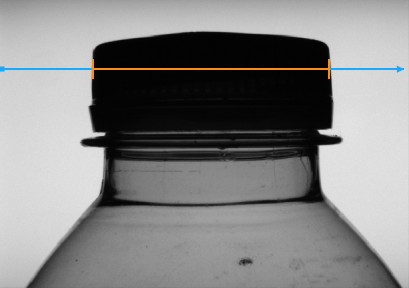You are here: Start » Filter Reference » Computer Vision » 1D Edge Detection » ScanSingleStripe
| Module: | MetrologyBasic |
|---|
Locates the strongest pair of edges across a given path (without a scan map).
Applications
| Name | Type | Range | Description | |
|---|---|---|---|---|
 |
inImage | Image | Input image | |
 |
inScanPath | Path | Path along which the scan is performed | |
 |
inScanPathAlignment | CoordinateSystem2D* | Adjusts the scan path to the position of the inspected object | |
 |
inScanWidth | Integer | 1 -  |
Width of the scan field in pixels |
 |
inSamplingParams | SamplingParams | Parameters controlling the sampling process | |
 |
inStripeScanParams | StripeScanParams | Parameters controlling the stripe extraction process | |
 |
inStripeSelection | Selection | Selection mode of the resulting stripe | |
 |
inLocalBlindness | LocalBlindness* | Defines conditions in which weaker edges can be detected in the vicinity of stronger edges | |
 |
outStripe | Stripe1D? | Found stripe | |
 |
outAlignedScanPath | Path | Transformed input path | |
 |
outBrightnessProfile | Profile | Extracted image profile | |
 |
outResponseProfile | Profile | Profile of the edge (derivative) operator response | |
 |
diagSamplingPoints | PathArray | Array of paths each one containing the sampling points that contributes to a single value of the extracted profile | |
 |
diagSamplingStep | Real | Used distance between consecutive sampling points on the scan path | |
Description
The operation scans the image along inScanPath and locates the strongest stripe (i.e. a pair of opposite-polarity edges running across the path) of the given characteristics. If there is no such stripe then the outputs are set to NIL.
The optional parameter inScanPathAlignment defines a transform to be performed on the inScanPath so that the actual scan path (outAlignedScanPath) is adjusted to the position of the object, typically detected by one of Template Matching filters.
Hints
- Connect an input image to the inImage input.
- Create inScanPath which is more or less perpendicular to the stripes you want to detect. It should be long enough to anticipate all possible stripe locations.
- Define inStripeScanParams.StripePolarity to detect a particular edge type, and only that type.
- Use a local coordinate system connected to inScanPathAlignment to automatically adjust the measurement to variable object position (optional).
- If the noise level is high, try increasing inScanWidth and/or inStripeScanParams.SmoothingStdDev.
- If no stripe is found, try decreasing inStripeScanParams.MinMagnitude. Verify this with the values on the outResponseProfile output.
- If consecutive edges are closer than 6 pixels apart, change inStripeScanParams.ProfileInterpolation to Quadratic3.
Examples

ScanSingleStripe locates the strongest stripe across inScanPath.
Remarks
Read more about Local Coordinate Systems in Machine Vision Guide: Local Coordinate Systems.
This filter is a part of the 1D Edge Detection toolset. For a comprehensive introduction to this technique please refer to 1D Edge Detection and 1D Edge Detection - Subpixel Precision chapters of our Machine Vision Guide.
Hardware Acceleration
This operation is optimized for SSE2 technology for pixels of type: UINT8.
This operation is optimized for AVX2 technology for pixels of type: UINT8.
This operation is optimized for NEON technology for pixels of type: UINT8.
This operation supports automatic parallelization for multicore and multiprocessor systems.
Complexity Level
This filter is available on Basic Complexity Level.
Filter Group
This filter is member of ScanStripes filter group.
See Also
- ScanMultipleStripes – Locates multiple pairs of edges across a given path (without a scan map).
- ScanExactlyNStripes – Locates a specified number of multiple pairs of opposite edges across a given path (without a scan map).
- ScanSingleStripe – Locates the strongest pair of edges across a given path (without a scan map).

 Basic
Basic